Trial by type rating
Destination: The Phenom 300's left seat
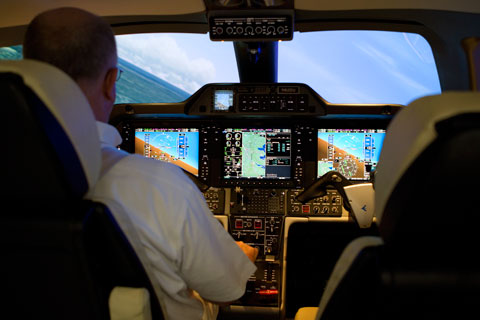
Brazilian manufacturer Embraer, traditionally known as a builder of 50- to 100-seat airliners, began a new strategy in 2005. That’s when the company decided to enter the business jet market. The first move was to build two light jets—the Phenom 100 and Phenom 300. The idea was to make these airplanes comply with FAR Part 23 rules, and make them modern, largely digitally controlled clean-sheet designs with the performance and price to blow the competition away. Oh, and be so easy to fly that only one pilot would be required. This, to appeal to the “step-up” market—pilots who want to transition into their first jet.
Today, more than 260 of its Phenom 100 entry-level light jets are in service. Another 40-plus Phenom 300s are flying. So the strategic and marketing aspects of the program seem to have been a success—especially in view of the current recession. But what about that single-pilot feature? Are these airplanes really so easy to fly that a typical piston driver can make the step up to a Phenom type rating? To find out, I went to CAE Simuflite’s training facility at the Dallas-Fort Worth International Airport to earn a single-pilot type rating in the Phenom 300.
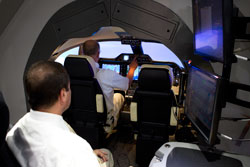 CAE Simuflite offers initial and recurrent training for several large business jets—among them Bombardier Challengers, Dassault Falcons, plus Gulfstreams, Hawkers, and King Air 200s. Every year, thousands of pilots from around the world come to DFW to fly CAE Simuflite’s Level C and D simulators. For the Phenom courses, Embraer partners with CAE Simuflite under the corporate title Embraer CAE Training Services, LLC (ECTS).
CAE Simuflite offers initial and recurrent training for several large business jets—among them Bombardier Challengers, Dassault Falcons, plus Gulfstreams, Hawkers, and King Air 200s. Every year, thousands of pilots from around the world come to DFW to fly CAE Simuflite’s Level C and D simulators. For the Phenom courses, Embraer partners with CAE Simuflite under the corporate title Embraer CAE Training Services, LLC (ECTS).
Course structure
Right up front, let’s make it clear that the Phenom 300 is not a very light jet. It’s a 450-knot, 1,900-nm, swept-wing eight-seater with a maximum takeoff weight of 17,968 pounds. You could easily make a case for this airplane’s being a two-pilot airplane (and many operators do fly it using “two-crew”) because of its speeds, slipperiness, and workloads in certain flight regimes. So if you want a single-pilot type rating, expect to cram two pilots’ worth of skill and information into your brain.
The work begins before you even arrive at DFW. There’s an online systems course that takes you through 25 chapters of material covering each of the airplane’s systems. Then you have to pass a 40-question test.
Checkride tasks
As of May, here are the required checkride tasks for ECTS' Phenom 300 type rating checkride. Other tasks and emergencies can be added, depending on the examiner. All of the approaches are conducted in the simulator, set to instrument meteorological conditions, at New York's John F. Kennedy International Airport. Of course, an oral exam takes place before the practical test.
- An RNAV departure procedure
- The VOR Runway 4L approach, with a missed approach and holding at DUFFY intersection
- The RNAV GPS Runway 4R approach, with a circle to land on runway 31R. Hand-flown.
- A V 1 cut on takeoff
- The ILS Runway 22L approach, hand-flown with an engine inoperative
- The ILS approach to Runway 4R, autopilot-flown with an engine inoperative
- A no-flaps visual approach to a designated runway
Once on site, the 15-day training sessions begin in earnest. The first six days are all ground school, and three of those days are 10 hours long. Desktop avionics simulators and ECTS’ Simfinity instrument procedures trainer (IPT) augment the classroom learning. These training devices are a big help in learning the Phenom 100’s and 300’s Prodigy avionics suite. The Prodigy is, at its core, a Garmin G1000 tailored to the Phenom’s systems. In addition to all the navigation and flight guidance features you’d expect to find in, say, a newer piston single with a Garmin navigator, the Prodigy has a multifunction display (MFD) that shows engine gauges, plus pressurization, electrical system, flight control, landing gear, and fuel status. There are also dedicated MFD pages for the electrical, fuel, environmental control, ice protection, oxygen, and hydraulic systems. There is also a page for calculating the airplane’s weight buildup.
For a piston pilot with experience flying Garmin’s GNS430 or 530 GPS/navcoms, much of the Prodigy will be familiar. But many trainees come from airplanes that use Rockwell Collins’ Pro Line 21 or Honeywell flight management systems (FMSs) and avionics. For them, the G1000 is a strange new world.
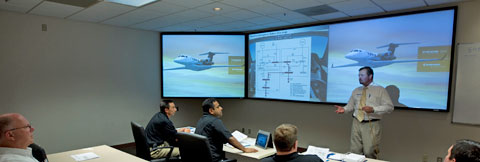
I was in a class with four pilots from Flight Options, the fractional ownership company that recently purchased 50 Phenom 300s (with an option to buy 50 more) to augment its 110-plus fleet of Beechjets, Hawker 800s, and Citation Xs. These pilots—Brian Goettle, Jeff Martin, Michael Minellono, and Vinny Puthusseril—were accustomed to flying two-crew in Beechjets. Although they were eager to transition into the Phenom 300, they were used to the Pro Line 21 FMS. Their learning curve wasn’t difficult, thanks to the desktops simulators and the Simfinity. But ECTS instructors emphasize that switching to the Prodigy presents huge challenges to many pilots. So if you’re Garmin-proficient and thinking of trading up to a Phenom (the Phenom 100 also uses the Prodigy) then you’ve got a leg up on a very steep learning curve.
Learning the systems
The good news is that the Phenom 300 systems are simple, which helps make the type rating oral exam a little bit easier. Many functions are automatic, so most normal switch positions are to an “On” or “Auto” position. Should a failure or abnormal event occur, the Phenom’s electronic brains—located in an electronics bay aft of the lavatory—command the corrective action. Bleed air leak? Sensors in the bleed air lines detect it, the air management system controller automatically shuts down the affected line, and a crossbleed valve shuts off the flow of bleed air from the other engine. Hot start? The FADECs (full authority digital engine controllers) automatically shut the engine down. Suddenly lose both starter-generators? The emergency bus automatically comes on line.
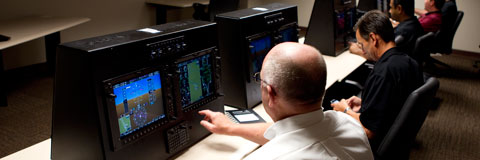
The bad news is that there is still a lot to learn. The spoilers won’t deploy if the flaps are extended. Using the Flaps Full position is prohibited (this restriction may be eliminated). The Flaps 2 and 3 positions have the same deflection, but at Flaps 3 certain Terrain Awareness and Warning System (TAWS) alerts are suppressed. Use a trim switch for more than three seconds and the trim servo will automatically shut off—a tactic intended to warn of, and prevent, trim runaways. The ventral rudder is active reaching 60 knots on the takeoff run, but goes to the inactive, streamlined position when the yaw damper is engaged. If the electronics bay overheats, go to manual control of the air conditioning system, select Cold for five seconds, then wait 90 seconds and see if the EBAY OVHT light goes out. If it doesn’t, procedures call for a descent to 10,000 feet (or the MEA, whichever is higher), dumping the cabin pressure, shutting off the environmental system and landing as soon as possible.
Coming to terms with the sim
After the ground school it’s time for seven, two-hour simulator sessions. CAE Simuflite’s Level D, full-motion Phenom simulator, with its Tropos 6000 visual system (which uses Google Earth maps for low-altitude visuals) is a wonderful, high-tech exact replica of the Phenom 300 cockpit and behavior. It’s so faithful to the airplane that you earn your type rating in it—without ever setting foot in the real airplane. The first two simulator sessions are more or less get-acquainted rides, with flight director changes with and without the autopilot, stalls, steep turns, and an ILS and localizer approach. You’ll do landings, too. In the next session you tackle nonprecision approaches, with and without circling maneuvers. Emergency procedures are introduced at this point, and it’s then that you really realize how much workload can come your way in single-pilot jet operations.
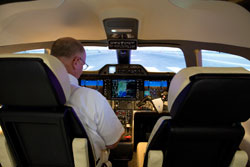 The third session focuses on engine-out scenarios, with V 1 cuts, single-engine approaches, and missed approaches. The Phenom 300’s 3,360-lbst PW535E engines can create huge amounts of asymmetric thrust when an engine is pulled at liftoff, so your legs get quite a workout—at a time when all hell can break loose (where many have “crashed” the simulator) as you try to maintain heading while climbing away. Engine fires occur, as do fuel imbalances and other random catastrophes. After three single-engine landings—two ILSs and a localizer-DME approach—you’re done for the day.
The third session focuses on engine-out scenarios, with V 1 cuts, single-engine approaches, and missed approaches. The Phenom 300’s 3,360-lbst PW535E engines can create huge amounts of asymmetric thrust when an engine is pulled at liftoff, so your legs get quite a workout—at a time when all hell can break loose (where many have “crashed” the simulator) as you try to maintain heading while climbing away. Engine fires occur, as do fuel imbalances and other random catastrophes. After three single-engine landings—two ILSs and a localizer-DME approach—you’re done for the day.
This may all sound benign from your perspective as a reader, but jets are flown by the numbers—and sequences of rigid procedures—and the Phenom 300 is no exception. Doing everything right as a single pilot means staying well ahead of the airplane—this means knowing how and when to slow an airplane that doesn’t shed speed easily—having spot-on timing, and knowing how to instinctively program both the Prodigy and the automatic flight control system (the flight director and autopilot) functions. By the way, the flight control system is required for legal single-pilot operations. If it’s gone AWOL, then the flight is a no-go.
Although virtually all Phenom flying is done with the autopilot, as a single-pilot jet jockey you’re still extremely busy programming the next leg, setting the correct airspeeds and climb and descent modes, and always anticipating.
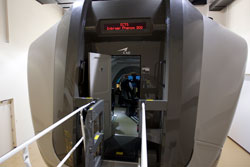 On nonprecision approaches, I programmed the vertical speed too late. This left me slightly high after passing the final approach fix. By the time I realized it, I didn’t have time to dial in a proper descent rate—which is 1,000 fpm on most approaches. The result? I’d select 1,200 or 1,300 fpm in an attempt to hit the minimum descent altitude at the proper point on the final approach course, only to find myself too high and fast to make a landing in the runway’s touchdown zone.
On nonprecision approaches, I programmed the vertical speed too late. This left me slightly high after passing the final approach fix. By the time I realized it, I didn’t have time to dial in a proper descent rate—which is 1,000 fpm on most approaches. The result? I’d select 1,200 or 1,300 fpm in an attempt to hit the minimum descent altitude at the proper point on the final approach course, only to find myself too high and fast to make a landing in the runway’s touchdown zone.
The sixth simulator session is a review of normal procedures, plus hot and high takeoffs and landings. By this time, I’d pretty much come to terms with the simulator and the airplane’s procedures and behavior. The seventh session is another review, which produces a recommendation to advance to the type rating check ride. This takes another two hours in the simulator.
The heat is definitely on when it comes to the checkride. An ECTS FAA-designated examiner sits at the simulator’s instructor station, watching your every move. Did I mention that the checkride is flown to Airline Transport Pilot (ATP) practical test standards? That means altitudes must be within 100 feet, headings within five degrees, and target airspeeds within 10 knots. When it comes to V REF—the speeds flown down final approach—the tolerances are even tighter. You can be no more than 10 knots faster than V REF but can never go below it.
Checkride angst
I spent the night before my checkride deep in study, knowing that I might forget some crucial item in the heat of battle. When my time came, I still wasn’t sure what to expect from either the examiner or myself during the fateful flight. And yet, I must have done well enough. It’s a proud moment when you finally earn any jet type rating, let alone one with single-pilot privileges. But after what I’d been through I wondered how others stepping up from high-performance piston-powered airplanes typically fared. It all depends, I learned.
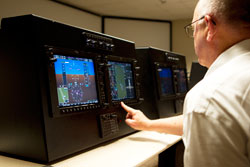 While it’s certainly possible to earn a single-pilot jet type rating, it’s worth relating ECTS instructor experiences with some owner-pilot trainees. Some come to school with just plain lousy instrument flying skills. A few arrived after recently earning a quickie, three-day multiengine rating in older piston twins. Still others made some instructors wonder how they even passed a private pilot checkride. None of this will do. Of course, any deficiencies are instantly identified once the simulator begins to move. Then it becomes a matter of additional training—or abandoning the idea of single-pilot flying in favor of two-crew operations.
While it’s certainly possible to earn a single-pilot jet type rating, it’s worth relating ECTS instructor experiences with some owner-pilot trainees. Some come to school with just plain lousy instrument flying skills. A few arrived after recently earning a quickie, three-day multiengine rating in older piston twins. Still others made some instructors wonder how they even passed a private pilot checkride. None of this will do. Of course, any deficiencies are instantly identified once the simulator begins to move. Then it becomes a matter of additional training—or abandoning the idea of single-pilot flying in favor of two-crew operations.
This is a side of the trend toward small, single-pilot jets that isn’t often raised. Scores of single-piloted, smaller, lighter jets have run off runways after flying approaches too fast, too high, or both. That’s a testament to the need to mind your speed and configuration. Flying light and very light jets single-pilot is fine, but there’s a price to pay for the right to sit up front all by your lonesome. That price is skill, discipline, and experience. Put simply, you really have to have your act together. And in my opinion, if it’s your first jet don’t even think about jumping into solo single-pilot flying the day after you’ve earned the type rating. Hire a salty mentor pilot to fly right seat for the first 50 hours or so. Besides, most insurance companies won’t cover you if you don’t.
Email the author at [email protected].


